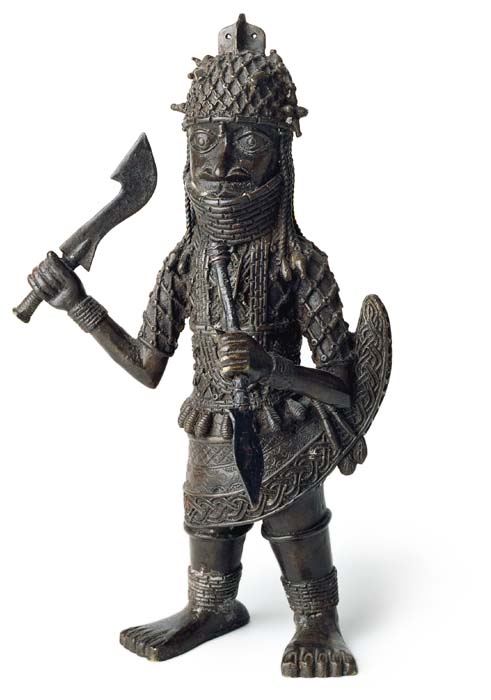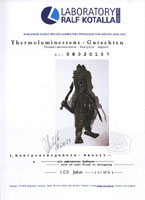Galerie Peter Herrmann |
- | Ancient Art from Africa |
||
 |
| Warrior | Thermoluminescence - Expertise |
| Benin, Nigeria +- 1900 Bronze. 35 cm |
 |
| Edited since 2008 old german collection since 1960 |
Description |
Translated with www.DeepL.com/Translator Depiction of a high military officer. Recognisable by the richly decorated wraparound skirt with side binding, the bonnet with unusual attachment and the stand-up collar of red coral, net shirt, spear and sword. As often seen in the late phase, the nose, mouth and eyes are somewhat more disproportionate than in most older depictions. The first tendencies towards a new realism can be seen, which have to do with refinements in casting technique from the end of the 19th century*. Small bells around the hip area are depicted in great detail. Likewise a low hanging neck ornament, which must actually already be called a bib. As on the neck, this high military man still wears ornaments of coral in the area of the knuckles of the hands and feet. The hairstyle consists of long plaits with a pearl at the end. Inconspicuously, one can see that under the traditional, richly ornamented wraparound skirt, he wears a pair of plain trousers, which, from their length, would be called shorts today. It can be assumed, because of some accessories impractical for warfare, that it is the uniform for festivities. With an age of about 100 years, this statue belongs to the late Benin period. The sculpture comes from the estate of a collection assembled in the 1960s. As was customary at the time, the figure was meticulously cleaned and given a protective and embellishing coating. Samples for a thermoluminescence analysis could be found in the outer area of the mouthguard and in a foot inside without having to drill into the sealed areas in the arms. *In the middle of the 19th century and again at the beginning of the colonial period, metal in various alloys became strikingly cheaper. This enabled a broader stratum of the population to commission bronzes. Due to the increase in numbers and stylistic influences from outside, representations changed. They were richer in detail and had a new tendency towards mannered overload. Contrary to many theories of demise, Peter Herrmann's exhibition, conceived as early as the 1990s, exhibited newer objects from the last 100 years in order to show that casting techniques in some regions of Africa were constantly improving. |